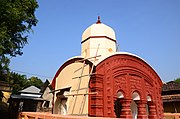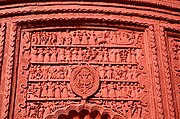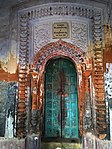Radhakantapur
Radhakantapur | |
|---|---|
Village | |
 Radhakantapur Location in West Bengal, India | |
| Coordinates: 22°33′37″N 87°44′39″E / 22.5603°N 87.7441°ECoordinates: 22°33′37″N 87°44′39″E / 22.5603°N 87.7441°E | |
| Country | |
| State | West Bengal |
| District | Paschim Medinipur |
| Population (2011) | |
| • Total | 2,473 |
| Languages | |
| • Official | Bengali, English |
| Time zone | UTC+5:30 (IST) |
| PIN | 721211 |
| Telephone/STD code | 03225 |
| Lok Sabha constituency | Ghatal |
| Vidhan Sabha constituency | Daspur |
| Website | paschimmedinipur |
Radhakantapur is a village in the Daspur I CD block in the Ghatal subdivision of the Paschim Medinipur district in the state of West Bengal, India.
Geography[]
M: municipal city/ town, R: rural/ urban centre, H: historical/ religious centre
Owing to space constraints in the small map, the actual locations in a larger map may vary slightly
Location[]
Radhakantapur is located at 22°33′37″N 87°44′39″E / 22.5603°N 87.7441°E.
Area overview[]
Ishwar Chandra Vidyasagar, scholar, social reformer and a key figure of the Bengal Renaissance, was born at Birsingha on 26 September 1820.[1][2]
Ghatal subdivision, shown in the map alongside, has alluvial soils. Around 85% of the total cultivated area is cropped more than once.[3] It has a density of population of 1,099 per km2, but being a small subdivision only a little over a fifth of the people in the district reside in this subdivision. 14.33% of the population lives in urban areas and 86.67% lives in the rural areas.[4]
Note: The map alongside presents some of the notable locations in the subdivision. All places marked in the map are linked in the larger full screen map.
Demographics[]
According to the 2011 Census of India, Radhakantapur had a total population of 2,473, of which 1,242 (50%) were males and 1,231 (50%) were females. There were 281 persons in the age range of 0–6 years. The total number of literate persons in Radhakantapur was 1,749 (79.79% of the population over 6 years).[5]
Education[]
Radhakantapur High School is a Bengali-medium coeducational institution established in 1966. The school has facilities for teaching from class V to class XII. It has a library with 612 books, 1 computer and a playground.[6]
Culture[]
David J. McCutchion classifies the Gopinath (mentioned as Panchananda) temple as an ek-ratna of the smaller Daspur type, measuring 22’ x 28’, with rich terracotta façade. He classifies the Dadhibamna temple (name not mentioned, only place mentioned) as a richly decorated pancha-ratna with smooth rekha turrets.[7]
The Gopinath temple is a state protected monument.[8]
Radhakantapur picture gallery[]

Ek-ratna Gopinath temple, established in 1844 and owned by the Das family

Terracotta panel

Terracotta relief

Pancha-ratna Dadhi Bamna temple, established in 1770 and owned by the Bose family.

Not much terracotta remains in the Dadhi Bamna temple. This picture shows some stucco decoration.
The pictures are a part of Wiki Explores Paschim Medinipur programme, an initiative by West Bengal Wikimedians User Group
References[]
- ^ Murshid, Ghulam. "Vidyasagar, Pundit Iswar Chandra". Banglapedia. Retrieved 24 July 2016.
- ^ "Ishwar Chandra Vidyasagar". www.whereincity.com. Retrieved 24 July 2016.
- ^ "District Human Development Report Paschim Medinipur, 2011". page 27-28. Department of Planning and Statistics, Government of West Bengal. Retrieved 10 September 2020.
- ^ "District Statistical Handbook Paschim Medinipur, 2013". Table 2.2, 2.4 (a). Department of Planning and Statistics. Retrieved 10 September 2020.
- ^ "CD block Wise Primary Census Abstract Data(PCA)". West Bengal – District-wise CD blocks. Registrar General and Census, India. Retrieved 21 August 2020.
- ^ "Radhakantapur H.S. U.Pry". Schools.org. Retrieved 21 August 2020.
- ^ McCutchion, David J., Late Mediaeval Temples of Bengal, first published 1972, reprinted 2017, pages 43, 49. The Asiatic Society, Kolkata, ISBN 978-93-81574-65-2
- ^ List of State Protected Monuments as reported by the Archaeological Survey of India Archived 2013-05-23 at the Wayback Machine.
External links[]
| Wikimedia Commons has media related to Radhakantapur, Daspur I CD block. |
- Villages in Paschim Medinipur district
- West Bengal geography stubs







